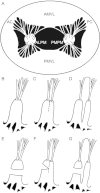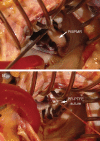Mitral valve repair for post-myocardial infarction papillary muscle rupture
- PMID: 23520228
- PMCID: PMC3858020
- DOI: 10.1093/ejcts/ezt150
Mitral valve repair for post-myocardial infarction papillary muscle rupture
Abstract
Objectives: Papillary muscle rupture (PMR) is a rare, but serious mechanical complication of myocardial infarction (MI). Although mitral valve replacement is usually the preferred treatment for this condition, mitral valve repair may offer an improved outcome. In this study, we sought to determine the outcome of mitral valve repair for post-MI PMR and to provide a systematic review of the literature on this topic.
Methods: Between January 1990 and December 2010, 9 consecutive patients (mean age 63.5 ± 14.2 years) underwent mitral valve repair for partial post-MI PMR. Clinical data, echocardiographic data, catheterization data and surgical reports were reviewed. Follow-up was obtained in December of 2012 and it was complete; the mean follow-up was 8.7 ± 6.1 (range 0.2-18.8 years).
Results: Intraoperative and in-hospital mortality were 0%. Intraoperative repair failure rate was 11.1% (n = 1). Freedom from Grade 3+ or 4+ mitral regurgitation and from reoperation at 1, 5, 10 and 15 years was 87.5 ± 11.7%. Estimated 1-, 5-, 10- and 15-year survival rates were 100, 83.3 ± 15.2, 66.7 ± 19.2 and 44.4 ± 22.2%, respectively. There were 3 late deaths, and 2 were cardiac-related. All late survivors were in New York Heart Association Class I or II. No predictors of long-term survival could be identified.
Conclusions: Mitral valve repair for partial or incomplete post-MI PMR is reliable and provides good short- and long-term results, provided established repair techniques are used and adjacent tissue is not friable. PMR type and adjacent tissue quality ultimately determine the feasibility and durability of repair.
Keywords: Mitral regurgitation; Mitral valve repair; Myocardial infarction; Outcome; Papillary muscle.
Figures



References
-
- Braunwald E. Valvular heart disease. In: Braunwald E, editor. Heart Disease: A Textbook of Cardiovascular Medicine. 4th edn. Philadelphia, PA: WB Saunders; 1992. p. 1019.
-
- Wei JY, Hutchins GM, Bulkley BH. Papillary muscle rupture in fatal acute myocardial infarction: a potentially treatable form of cardiogenic shock. Ann Intern Med. 1979;90:149–53. - PubMed
-
- Nishimura RA, Schaff HV, Shub C, Gersh BJ, Edwards WD, Tajik AK. Papillary muscle rupture complicating acute myocardial infarction: analysis of 17 patients. Am J Cardiol. 1983;51:373–7. doi:10.1016/S0002-9149(83)80067-8. - DOI - PubMed
-
- Sanders RJ, Neubuerger KT, Ravin A. Rupture of papillary muscles: occurrence of rupture of the posterior muscle in posterior myocardial infarction. Dis Chest. 1957;31:316–23. doi:10.1378/chest.31.3.316. - DOI - PubMed
-
- Kishon Y, Oh JK, Schaff HV, Mullany CJ, Tajik AJ, Gersh BJ. Mitral valve operation in postinfarction rupture of a papillary muscle: immediate results and long-term follow-up of 22 patients. Mayo Clin Proc. 1992;67:1023–30. doi:10.1016/S0025-6196(12)61116-1. - DOI - PubMed
Publication types
MeSH terms
Grants and funding
LinkOut - more resources
Full Text Sources
Other Literature Sources
Medical

